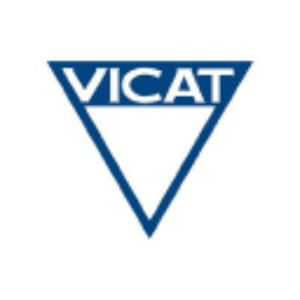Vicat: 2022 Results
L’ISLE-D’ABEAU,
Vicat (Paris:VCT):
- Strong increase in sales: resilient volumes across almost all markets and significantly higher selling prices
-
Profitability adversely affected by the significant increase in energy prices and non-recurring industrial costs in
the United States ,France andIndia - Solid cash generation and robust balance sheet despite the growth in the working capital requirement
-
Proposed dividend at
€1.65 per share
Condensed income statement approved by the Board of Directors on
(€ million) |
2022 |
|
2021 |
|
Change (reported) |
|
Change
|
|
Consolidated sales |
3,642 |
|
3,123 |
|
+ |
|
+ |
|
EBITDA* |
570 |
|
619 |
|
– |
|
– |
|
Margin (%) |
|
|
|
|
|
|
|
|
Recurring EBIT* |
284 |
|
360 |
|
– |
|
– |
|
Margin (%) |
|
|
|
|
|
|
|
|
Consolidated net income |
175 |
|
222 |
|
– |
|
– |
|
Margin (%) |
|
|
|
|
|
|
|
|
Net income, Group share |
156 |
|
204 |
|
– |
|
– |
|
Cash flow from operations |
461 |
|
488 |
|
–5, |
|
– |
*Definitions in the appendix of this press release
Commenting on these figures,
We have made progress with our policy of lowering our greenhouse gas emissions by harnessing existing solutions and investing in technologies that will enable us to reach our new 2030 targets.”
Disclaimer:
- In this press release, and unless indicated otherwise, all changes are stated on a year-on-year basis (2022/2021), and at constant scope and exchange rates.
- The alternative performance measures (APMs), such as “at constant scope and exchange rates”, “operational sales”, “EBITDA”, “Recurring EBIT”, “net debt”, “gearing” and “leverage” are defined in the appendix to this press release.
- This press release may contain forward-looking statements. Such forward-looking statements do not constitute forecasts regarding results or any other performance indicator, but rather trends or targets. These statements are by their nature subject to risks and uncertainties as described in the Company’s annual report available on its website (www.vicat.fr). These statements do not reflect the future performance of the Company, which may differ significantly. The Company does not undertake to provide updates of these statements.
Further information about Vicat is available from its website (www.vicat.fr).
-----------------------------------------------------------------------------------------------------------------------------------
The Group posted strong sales growth in 2022 driven by a significant rise in its selling prices. This performance reflected:
- an increase in selling prices across almost all Vicat’s markets amid strong cost inflation;
-
resilient Cement and Concrete volumes in most markets, except for
Turkey ; -
negative non-recurring items in
the United States , with the longer-than-anticipated start-up of theRagland plant’s new kiln, and inIndia , with debottlenecking operations to boost capacity at the Kalburgi plant during the third quarter; and -
the consequences of the political environment in
Mali .
Overall, the Group’s consolidated sales totalled
Consolidated sales rose +
- a scope effect of –
- a negative currency effect of –
- organic growth of +
The Group’s operational sales totalled
Vicat’s consolidated EBITDA came to
At constant scope and exchange rates, the EBITDA decrease was primarily attributable to:
- a particularly unfavourable basis of comparison in 2021 as a result of the post-Covid rebound in business;
-
very strong inflation in production costs, and especially in energy, since the second half of 2021, with a significant acceleration in 2022. As a result, energy costs soared +
67% to€664 million over the full year, up from€398 million in 2021. This inflation was offset only gradually by a general increase in selling prices; -
Lastly, EBITDA was adversely affected by several non-recurring industrial operations that held back performance throughout the year:
-
the start-up of Ragland’s new kiln in
the United States during the second and third quarters; -
the operational upgrade in the first quarter of the Montalieu plant after two pandemic-blighted years;
-
the capacity increase at the
Kalburgi Cement plant during the third quarter.
-
the start-up of Ragland’s new kiln in
These three operations will have a highly positive impact on future levels of operating profitability.
Recurring EBIT came to
Operating income came to
Of this –
-
–
€3 million derived from the increase in the Group’s average debt and interest, partially offset by the increase in investment income and the positive change in the fair value of interest-rate hedging derivatives; and -
–
€12 million derived from the application of IAS 29 inTurkey and –€7 million from the currency loss arising from the devaluation of the Egyptian pound against the euro.
The macroeconomic and inflationary situation in
-
restatement of the opening balance sheet at
1 January 2022 , leading to a +€59 million impact on the Group’s share of equity; -
an impact on the 2022 income statement of –
€20.8 million (€12 million via net financial income (expense).
Tax expense declined
This reduction in tax derived primarily from the fall in the Group’s taxable income and the new tax convention applicable in
Consolidated net income was
Net income, Group share fell –
Cash flow from operations came to
On the strength of these full-year 2022 results and given its confidence in the Group’s ability to continue pursuing its development, the Board of Directors decided at its meeting on
1. Income statement analysed by geographical region
1.1. Income statement,
(€ million) |
2022 |
|
2021 |
|
Change (reported) |
|
Change
|
|
Consolidated sales |
1,177 |
|
1,074 |
|
+ |
|
+ |
|
EBITDA |
172 |
|
201 |
|
– |
|
– |
|
Recurring EBIT |
75 |
|
118 |
|
– |
|
– |
The Group’s sales in
EBITDA declined significantly during the period given the very clear increase in operating costs, particularly energy costs (up +
-
In the Cement business, operational sales rose +
10.6% at constant scope. Given the unfavourable basis of comparison resulting from the French market’s dynamic performance last year, this increase reflects a slight drop-off in demand offset by a gradual, but significant rise in selling prices during the year. Nonetheless, the price increases introduced offset only partially the very strong increase in energy costs. One-off maintenance operations carried out in a period of high activity levels after the two-year-long Covid-19 pandemic gave rise to non-recurring costs at the beginning of the year. The EBITDA generated by this business declined by –14.3% . -
The operational sales recorded by the Concrete & Aggregates business rose +
3.8% at constant scope. This performance was driven by a significant improvement in selling prices throughout the year, offsetting the impact of a small contraction in volumes. Given the increase in costs, the EBITDA generated by the business moved down –20.3% at constant scope. -
In the Other Products & Services business, operational sales advanced +
8.4% at constant scope over the period. The EBITDA recorded by the business fell –8.3% over the period.
1.2 Income statement for
(€ million) |
2022 |
|
2021 |
|
Change (reported) |
|
Change
|
|
Consolidated sales |
388 |
|
394 |
|
– |
|
+ |
|
EBITDA |
85 |
|
89 |
|
– |
|
– |
|
Recurring EBIT |
51 |
|
55 |
|
– |
|
– |
Business trends in
In
-
In the Cement business, operational sales moved up +
1.1% at constant scope and exchange rates. This performance reflects a contraction in volumes during the year, offset by a solid increase in selling prices. Taking into account these factors and also the strong increase in energy costs, particularly electricity, which accelerated considerably during the second half, the EBITDA generated by the business dropped –16.7% at constant scope and exchange rates. -
In the Concrete & Aggregates business, operational sales declined –
3.8% at constant scope and exchange rates. Amid a contraction in both concrete and aggregates volumes, selling prices moved higher in concrete and were almost stable in aggregates. As a result of these factors, the EBITDA generated by this business fell –8.0% at constant scope and exchange rates. -
In the Other Products and Services business, operational sales fell were almost stable at constant scope and exchange rates (down –
0.9% ). The EBITDA generated by the business rose +4.9% at constant scope and exchange rates, given the accretive impact of the Creabeton disposal in the first half of 2021.
In
1.3 Income statement for the
(€ million) |
2022 |
|
2021 |
|
Change (reported) |
|
Change
|
|
Consolidated sales |
860 |
|
672 |
|
+ |
|
+ |
|
EBITDA |
135 |
|
140 |
|
– |
|
– |
|
Recurring EBIT |
72 |
|
84 |
|
– |
|
– |
Demand across the
In the
Construction of the
-
In the Cement business, operational sales in the region grew +
6.4% at constant scope and exchange rates in 2022, reflecting the strength of the construction market in the regions in which the Group operates and a significant increase in selling prices.
Even so, given the surge in energy costs and specific costs linked to the start-up of theRagland plant’s new kiln, the EBITDA generated by the business declined by –15.4% at constant scope and exchange rates.
-
In the Concrete business, operational sales rose +
6.0% at constant scope and exchange rates as further positive market trends continued to provide support for the business. Against this backdrop, selling prices moved significantly higher. Nonetheless, the EBITDA recorded by this business fell over the period, indirectly as a result of the start-up of theRagland plant’s new kiln amid the stretched cement supply conditions prevailing in the region.
In
-
In the Cement business, operational sales were
€218 million , an increase of +23.0% at constant scope and exchange rates, supported by robust demand and a large increase in selling prices. Nonetheless, higher selling prices made up only partially for the very strong increase in energy costs. Overall, EBITDA fell –19.3% at constant scope and exchange rates. -
In the Concrete & Aggregates business, operational sales came to
€92 million , an increase of +44.2% at constant scope and exchange rates. Market conditions remained favourable throughout the period, and they were supported by an increase in concrete and aggregates selling prices. Amid these positive conditions, EBITDA rose sharply.
1.4
(€ million) |
2022 |
|
2021 |
|
Change (reported) |
|
Change
|
|
Consolidated sales |
500 |
|
428 |
|
+16.8 |
|
+ |
|
EBITDA |
98 |
|
122 |
|
– |
|
– |
|
Recurring EBIT |
64 |
|
88 |
|
– |
|
– |
Sales in
As a result, EBITDA fell to
Consolidated sales in
1.5 Mediterranean (
(€ million) |
2022 |
|
2021 |
|
Change (reported) |
|
Change
|
|
Consolidated sales |
374 |
|
228 |
|
+ |
|
+ |
|
EBITDA |
44 |
|
3 |
|
n.a |
|
n.a |
|
EBIT |
20 |
|
–15 |
|
n.a |
|
n.a |
In the Mediterranean region, sales moved sharply higher in both countries amid a persistent lack of visibility. The key factor behind the increase was a large hike in selling prices, sparking a significant recovery in operating profitability.
In
EBITDA recorded a significant increase over the full year to
-
In the Cement business, the Group decided to limit the use of its least energy-efficient manufacturing facilities to curb the impact of higher costs in a hyperinflationary environment. Taking these factors into account plus the slowdown in the construction sector amid economic conditions affected by inflation, volumes delivered fell over the period in order to protect margins. The volume contraction was offset to a very large extent by higher prices. As a result, the business’ operational sales climbed +
235.3% at constant scope and exchange rates to€192 million . Overall, the EBITDA generated by the business totalled over€33 million , despite the depreciation in the Turkish lira, versus€10 million in 2021. -
In the Concrete & Aggregates business, operational sales rose +
219.3% at constant scope and exchange rates to€117 million . While concrete deliveries declined over the full year, aggregate deliveries posted solid growth as a result of a dynamic second-half performance. Significant price hikes were introduced, following the Cement business’ lead. The EBITDA generated by the business lay well inside positive territory.
In
1.6
(€ million) |
2022 |
|
2021 |
|
Change (reported) |
|
Change
|
|
Consolidated sales |
343 |
|
327 |
|
+ |
|
+ |
|
EBITDA |
36 |
|
65 |
|
– |
|
– |
|
EBIT |
2 |
|
30 |
|
– |
|
– |
In
-
In the Cement business, operational sales in the
Africa region fell –2.1% at constant scope and exchange rates. While business trends picked up inSenegal and improved significantly inMauritania , these factors did not fully offset the sharp contraction in Mali’s market as a result of the political environment. Selling prices rose in both these markets, but not sufficiently to make up for the impact of the cost inflation observed in the region, particularly as a result of the selling price controls introduced by the Senegalese authorities. Overall, the EBITDA generated by the business fell –53.0% over the period. -
In
Senegal , the Aggregates business, supported by the gradual resumption of major government construction projects, recorded operational sales of€38 million , up +28.2% at constant scope and exchange rates. Volumes grew sharply during the year, while selling prices fell due to an unfavourable product and customer mix. EBITDA rose +4.2% over the year to reach€9 million .
2. Changes in the Group’s financial position at
At
Net debt totalled
On this basis, the Group’s leverage ratio stood at 2.75x (versus 2.13x at
Medium- to long-term borrowings are subject to special clauses (covenants) requiring certain financial ratios to be met. Given the level of Group’s net debt and balance sheet liquidity, the bank covenants do not pose a risk for the Group’s financial position. At
3. Capital expenditure and free cash flow
Net capital expenditure totalled
Gross industrial investments amount to
Maintenance capex amounted to
On this basis, free cash flow (before strategic capex) came to
Strategic growth capex totalled
Lastly, the Group’s strategic capex allocated to reducing the carbon footprint totalled
As a result, free cash flow (after strategic capex) amounted to –
The change in free cash flow stems from the decline in EBITDA and from the large increase in the working capital requirement attributable to raw materials cost inflation. The working capital requirement increased by over +
4. Recent events
4.1 Construction of a new kiln in
The Group, via its subsidiary
Construction of this new facility continued during 2022 in line with the Group’s expectations. The new production facility is scheduled for commissioning in mid-2024.
On
-
a 10-year
€120 million tranche granted by theInternational Finance Corporation (IFC); - a 6-year CFA80 million fixed-rate tranche syndicated by the IFC to a pool of local lenders.
This long-term loan will provide refinancing for
Given the performance of the project currently under construction, which will use best-in-class technologies to achieve a carbon intensity of 460 kg gross/per tonne in CO2 emissions, the portion related to this project qualified as “green financing” on the basis of a “Second Party Opinion” issued by a top-tier agency. The Vicat group has thus reached another milestone through the alignment of its financing arrangements with its environmental goals.
4.2 Climate Plan: 2022 results and update to the Group’s carbon footprint reduction targets
2022 was an important year for the
In
This performance was achieved as a result of:
-
a significant increase in the proportion of alternative fuels, which rose from
26.2% in 2021 to28.1% of the fuel mix in 2022 (66.0% inEurope versus62.9% in 2021); -
a significant decline in the clinker rate in cement to
77.5% in 2022 from78.9% in 2021.
Efforts made at every tier of the organisation led to an upgrade in the Group’s CDP rating to A- (from B in 2021).
Based on these achievements, the 2030 target for reducing the Group’s CO2 emissions has been made even more demanding.
The revised target for 2030 is now CO2 emissions of 497 kg net per tonne of cement equivalent (rather than 540 kg previously), and 430 kg in
This new target is based on:
-
an increase in the use of alternative fuels to
50% of the Group’s overall fuel mix (versus40% previously), and to100% inEurope ; -
a reduction in the clinker rate in cement to
69% , versus75% previously; - the use of modern industrial facilities.
It’s worth reiterating that greater use of alternative fuels and a reduction in the proportion of clinker in cement are the main ways of achieving these targets, and they involve the use of existing mature technologies. These targets do not take into account any regulatory changes that may occur in the period out to 2030 or the introduction of so-called Carbon Capture & Storage or Carbon Capture & Usage technologies, which the Group is working on separately.
During 2022, the Group stepped up its commitment to the energy transition by introducing a target of using low-emission renewable energies. By 2030, the Group aims to increase its use of electricity generated from renewable sources to
5. Outlook for 2023
In 2023, the Group is targeting further significant sales growth, with its markets overall expected to display resilience and reflect the full benefit of the price hikes in selling prices introduced in 2022 and the fresh increases anticipated in 2023. Furthermore, the financial year 2023 will benefit from the full effect of the new
In 2023 and 2024, the Group plans to scale back its capital expenditure outlays to around
-
completion of the construction work on the new kiln in
Senegal ; - investment projects to meet the carbon footprint reduction targets; and
- maintenance capex.
The Group does not plan to launch any further strategic growth capex projects until the leverage ratio has been brought down below 2.0x.
The Group wishes to make clear that these anticipated trends per country are highly dependent on how the war in
-
in
France , demand may tail off slightly during the year, with conditions affected by inflation and interest rate hikes. Selling prices are expected to rise further, however, to offset cost inflation, particularly in energy costs; -
in
Switzerland , the market is expected to remain resilient throughout the year, stabilising progressively. As inFrance , selling prices are expected to increase, after the increases introduced at the beginning of the year; -
in
the United States , the market is expected to keep moving in a positive direction with the impact of the economic stimulus plan being rolled by the US administration. In this market, the Group will reap the benefit of the commercial ramp-up in the new industrial facility commissioned in 2022 amid favourable price conditions; -
in
Brazil , business levels in the markets in which the Group operates are expected to remain broadly stable over the year. Further price hikes are anticipated to offset the continuing increase in production costs. -
in
India , the macroeconomic and sector environment is expected to remain favourable. With prices still volatile, the rise in energy costs is only likely to be offset gradually; -
in
Kazakhstan , market conditions are expected to remain favourable despite a persistently high basis for comparison and fierce competition; -
in
Turkey , the Group will continue to focus on protecting its margins in a hyperinflationary environment amid challenging macroeconomic and political conditions that limit visibility; -
In
Egypt , the economic and monetary effects of the Ukrainian crisis have worsened the overall outlook. With the sector agreement in force sinceJuly 2021 remaining in place, the Group expects stable demand and further improvement in selling prices, which will curb the effects of inflation; -
in
West Africa , trends in Cement are expected to remain dynamic as a result of a favourable sector environment, especially after the recent reopening of the border withMali . With cement price controls still in placeSenegal , the full impact of cost increases is unlikely to be offset. The Aggregates business inSenegal is expected to continue its infrastructure project-led growth.
Presentation meeting and conference call
To accompany this publication, the Vicat group is holding an information conference call in English on
To take part in the conference call live, dial in on one of the following numbers:
US: +1 786 697 3501
The conference call will also be livestreamed from the Vicat website or by clicking here. A replay of the conference call will be immediately available for streaming via the Vicat website or by clicking here.
The presentation supporting the event will be available on Vicat’s website or by clicking here from
Next event:
First-quarter 2022 sales on
About Vicat
Vicat group – Financial data – Appendix
Definition of alternative performance measures (APMs):
- Performance at constant scope and exchange rates is used to determine the organic growth trend in P&L items between two periods and to compare them by eliminating the impact of exchange rate fluctuations and changes in the scope of consolidation. It is calculated by applying exchange rates and the scope of consolidation from the prior period to figures for the current period.
- A geographical (or a business) segment’s operational sales are the sales posted by the geographical (or business) segment in question less intra-region (or intra-segment) sales.
- Value-added: value of production less consumption of materials used in the production process.
- Gross operating income: value-added, less staff costs, taxes and duties (other than on income and deferred taxes).
- EBITDA (earnings before interest, tax, depreciation and amortisation): sum of gross operating income and other income and expenses on ongoing business.
- Recurring EBIT: (earnings before interest and tax): EBITDA less net depreciation, amortisation, additions to provisions and impairment losses on ongoing business.
- Cash flow from operations: net income before net non-cash expenses (i.e. predominantly depreciation, amortisation, additions to provisions and impairment losses, deferred taxes, gains and losses on disposals and fair value adjustments).
- Free cash flow: net operating cash flow after deducting capital expenditure net of disposals.
- Net debt represents gross debt (consisting of the outstanding amount of borrowings from investors and credit institutions, residual financial liabilities under finance leases, any other borrowings and financial liabilities excluding options to sell and bank overdrafts), net of cash and cash equivalents, including remeasured hedging derivatives and debt.
- Gearing is a ratio reflecting a company’s financial structure calculated as net debt/consolidated equity.
- Leverage is a ratio based on a company’s profitability, calculated as net debt/consolidated EBITDA.
Income statement by business
Cement
(€ million) |
2022 |
|
2021 |
|
Change (reported) |
|
Change
|
|
Volume (thousands of tonnes) |
27,140 |
|
28,141 |
|
– |
|
|
|
Operational sales |
2,296 |
|
1,914 |
|
+ |
|
+ |
|
Consolidated sales |
1,964 |
|
1,633 |
|
+ |
|
+ |
|
EBITDA |
411 |
|
456 |
|
– |
|
– |
|
Recurring EBIT |
233 |
|
300 |
|
– |
|
– |
|
Concrete & Aggregates
(€ million) |
2022 |
|
2021 |
|
Change (reported) |
|
Change
|
|
|
||
|
Concrete volumes (thousands of m3) |
10,023 |
|
10,472 |
|
– |
|
|
|||
|
Aggregates volumes (thousands of tonnes) |
25,310 |
|
23,998 |
|
+ |
|
|
|||
|
Operational sales |
1,398 |
|
1,191 |
|
+ |
|
+ |
|||
|
Consolidated sales |
1,363 |
|
1,158 |
|
+17.8 |
|
+ |
|||
|
EBITDA |
132 |
|
133 |
|
–1,3 |
|
– |
|||
|
Recurring EBIT |
42 |
|
49 |
|
– |
|
– |
|||
Other Products & Services
(€ million) |
2022 |
|
2021 |
|
Change (reported) |
|
Change
|
|
Operational sales |
454 |
|
453 |
|
+ |
|
+ |
|
Consolidated sales |
315 |
|
332 |
|
– |
|
+ |
|
EBITDA |
27 |
|
30 |
|
– |
|
+ |
|
Recurring EBIT |
10 |
|
11 |
|
– |
|
– |
|
Principal 2022 financial statements
The full 2022 consolidated financial statements, together with the notes, are now available on the Company’s website at: www.vicat.fr.
Consolidated Income Statement
(in thousands of euros) |
Notes |
2022 |
2021 |
|||
|
||||||
Revenue |
4 |
3,642,063 |
3,122,940 |
|||
Goods and services purchased |
|
(2,509,400) |
(2,002,119) |
|||
Employees expenses |
5 |
(528,635) |
(483,699) |
|||
Taxes |
|
(60,982) |
(56,968) |
|||
Other operating income (expenses) |
6 |
27,074 |
38,964 |
|||
EBITDA |
|
570,120 |
619,118 |
|||
Net charges to operating depreciation, amortization and provisions |
6 |
(285,655) |
(259,196) |
|||
Recurring EBIT |
|
284,465 |
359,922 |
|||
Other non-operating income (expenses) |
7 |
6,270 |
(28,291) |
|||
Net charges to non-operating depreciation, amortization and provisions |
7 |
(13,007) |
4,793 |
|||
Operating income (expense) |
|
277,728 |
336,424 |
|||
Cost of net financial debt |
|
(31,155) |
(28,442) |
|||
Other financial income |
|
31,900 |
19,363 |
|||
Other financial expenses |
|
(50,666) |
(20,919) |
|||
Financial income |
8 |
(49,921) |
(29,998) |
|||
Share of profit (loss) of associates |
11.1 |
12,697 |
5,156 |
|||
Profit (loss) before tax |
|
240,504 |
311,582 |
|||
Income tax |
9 |
(65,060) |
(89,398) |
|||
Consolidated net income |
|
|
|
175,444 |
|
222,184 |
Portion attributable to minority interests |
|
19,357 |
18,005 |
|||
Portion attributable to the Group |
|
156,086 |
204,179 |
|||
|
|
|
||||
Earnings per share (in euros) |
|
|
|
|||
Basic and diluted earnings per share |
|
3.48 |
4.55 |
Comprehensive income
(in thousands of euros) |
2022 |
2021 |
||
Consolidated net income |
175,444 |
222,184 |
||
|
|
|
||
Other items not recycled to profit or loss: |
|
|
||
Remeasurement of the net defined benefit liability |
30,649 |
7,350 |
||
Other items not recycled to profit or loss: |
|
(9,744) |
|
(2,127) |
Tax on non-recycled items |
(6,617) |
(2,574) |
||
|
|
|
||
Other items recycled to profit or loss: |
|
|
||
Changes in currency translation adjustments |
(20,849) |
69,699 |
||
Cash flow hedge instruments |
7,914 |
1,946 |
||
Tax on recycled items |
(2,053) |
(386) |
||
|
|
|
||
Other comprehensive income (after tax) |
(700) |
73,908 |
||
|
|
|
||
TOTAL COMPREHENSIVE INCOME |
174,744 |
296,092 |
||
Portion attributable to minority interests |
11,403 |
25,671 |
||
Portion attributable to the Group |
163,341 |
270,421 |
Consolidated statement of financial position
ASSETS |
||||||
(in thousands of euros) |
Notes |
|
|
|||
|
|
|||||
|
10.1 |
1,204,814 |
1,157,232 |
|||
Other intangible assets |
10.2 |
183,066 |
173,653 |
|||
Property, plant and equipment |
10.3 |
2,504,926 |
2,169,041 |
|||
Right of use related to leases |
10.4 |
193,122 |
195,112 |
|||
Investment properties |
10.5 |
32,124 |
32,218 |
|||
Investments in associated companies |
11.1 |
80,804 |
92,774 |
|||
Deferred tax assets |
9 |
126,212 |
68,012 |
|||
Receivables and other non-current financial assets |
11.2 |
269,651 |
219,241 |
|||
|
|
|
|
|
|
|
Total non-current assets |
|
4,594,719 |
4,107,283 |
|||
Inventories and work-in-progress |
12.1 |
560,795 |
429,243 |
|||
Trade and other accounts |
12.2 |
464,216 |
436,219 |
|||
Current tax assets |
9 |
45,201 |
6,947 |
|||
Other receivables |
12.3 |
204,690 |
206,475 |
|||
Asset held for sale |
|
11.1 |
|
21,780 |
|
|
Cash and cash equivalents |
13 |
503,597 |
527,393 |
|||
Total current assets |
|
1,800,279 |
1,606,277 |
|||
|
|
|
|
|
|
|
TOTAL ASSETS |
|
6,394,998 |
5,713,560 |
|||
|
||||||
SHAREHOLDERS’ EQUITY AND LIABILITIES |
|
|||||
|
||||||
(in thousands of euros) |
Notes |
|
|
|||
|
|
|||||
Capital |
|
179,600 |
179,600 |
|||
Additional paid-in capital |
|
11,207 |
11,207 |
|||
|
|
(47,097) |
(52,018) |
|||
Consolidated reserves |
|
3,003,393 |
2,800,579 |
|||
Translation reserves |
|
(558,838) |
(579,950) |
|||
Shareholders’ equity, Group share |
|
2,588,265 |
2,359,418 |
|||
Minority interests |
|
274,529 |
246,681 |
|||
Total shareholders’ equity |
14 |
2,862,794 |
2,606,099 |
|||
Provisions for pensions and other post-employment benefits |
15.1 |
86,355 |
108,529 |
|||
Other provisions |
15.2 |
123,413 |
104,974 |
|||
Financial debts and put options |
16.1 |
1,672,772 |
1,291,434 |
|||
Lease liabilities |
16.1 |
161,045 |
159,883 |
|||
Deferred tax liabilities |
9 |
325,188 |
219,800 |
|||
Other non-current liabilities |
|
21,594 |
23,927 |
|||
Total non-current liabilities |
|
2,390,367 |
1,908,547 |
|||
Provisions |
15.2 |
12,570 |
10,381 |
|||
Financial liabilities and put options at less than one year |
16.1 |
242,161 |
371,119 |
|||
Lease liabilities at less than one year |
16.1 |
47,537 |
55,502 |
|||
Trade and other accounts payable |
17.1 |
540,374 |
459,647 |
|||
Current taxes payable |
|
14,814 |
27,558 |
|||
Other liabilities |
17.2 |
284,381 |
274,707 |
|||
Total current liabilities |
|
1,141,837 |
1,198,914 |
|||
Total liabilities |
|
3,532,204 |
3,107,461 |
|||
|
|
|||||
TOTAL LIABILITIES AND SHAREHOLDERS’ EQUITY |
|
6,394,998 |
5,713,560
|
Consolidated statement of cash flow
(in thousands of euros) |
Notes |
2022 |
2021 |
|||
CASH FLOWS FROM OPERATING ACTIVITIES |
|
|
||||
|
|
|||||
Consolidated net income |
|
175,444 |
222,184 |
|||
|
|
|
|
|||
Share of profit (loss) of associates |
|
(12,697) |
(5,156) |
|||
Dividends received from associated companies |
|
7,057 |
1,208 |
|||
Elimination of non-cash and non-operating items: |
|
|
||||
- depreciation, amortization and provisions |
|
303,434 |
255,811 |
|||
- deferred taxes |
|
6,803 |
5,717 |
|||
- net gain (loss) from disposal of assets |
|
(5,377) |
(7,622) |
|||
- unrealized fair value gains (losses) |
|
(14,688) |
(3,625) |
|||
- others (1) |
|
1,055 |
19,070 |
|||
|
|
|||||
Cash flows from operating activities |
|
461,031 |
487,587 |
|||
|
|
|
||||
Change in working capital |
|
(104,132) |
(48,674) |
|||
|
|
|||||
Net cash flows from operating activities (2) |
18.1 |
356,899 |
438,913 |
|||
Recurring EBIT |
|
|
||||
CASH FLOWS FROM INVESTING ACTIVITIES |
|
|
||||
|
|
|||||
Outflows linked to acquisitions of non-current assets: |
|
|
||||
- tangible and intangible assets |
|
(422,356) |
(386,570) |
|||
- financial investments |
|
(28,505) |
(40,157) |
|||
|
|
|||||
Inflows linked to disposals of non-current assets: |
|
|
||||
- tangible and intangible assets |
|
13,975 |
10,759 |
|||
- financial investments |
|
4,392 |
4,105 |
|||
|
|
|||||
Impact of changes in consolidation scope |
|
(45,404) |
(31,005) |
|||
|
|
|||||
Net cash flows from investing activities |
18.2 |
(477,898) |
(442,868) |
|||
|
|
|
|
|||
CASH FLOWS FROM FINANCING ACTIVITIES |
|
|
||||
|
|
|||||
Dividends paid |
|
(82,355) |
(74,116) |
|||
Increases/decreases in capital |
|
|
||||
Proceeds from borrowings |
16.1 |
462,197 |
331,443 |
|||
Repayments of borrowings |
16.1 |
(138,328) |
(140,122) |
|||
Repayment of lease liabilities |
16.1 |
(58,414) |
(52,963) |
|||
Acquisitions of treasury shares |
|
(18,366) |
(22,887) |
|||
Disposals or allocations of treasury shares |
|
20,191 |
24,701 |
|||
|
|
|||||
Net cash flows from financing activities |
|
184,926 |
66,056 |
|||
Impact of changes in foreign exchange rates |
|
(23,022) |
9,182 |
|||
Change in cash position |
|
40,905 |
71,283 |
|||
Net cash and cash equivalents - opening balance |
13.2 |
430,442 |
359,159 |
|||
Net cash and cash equivalents - closing balance |
13.2 |
471,347 |
430,442 |
|||
(1) : |
||||||
- Including IAS 29 impacts (cf. Note 1.1) |
||||||
(2) : |
||||||
- Including cash flows from income taxes: |
||||||
- Cash flows from interests paid and received: |
||||||
Statement of changes in consolidated shareholder’s equity
(in thousands of euros) |
|
Capital |
Additional
|
|
Consolidated
|
Translation
|
Shareholders'
|
Minority
|
Total
|
|||
At |
179,600 |
11,207 |
(53,587) |
2,689,713 |
(640,805) |
2,186,128 |
234,306 |
2,420,434 |
||||
Net income |
204,179 |
204,179 |
18,005 |
222,184 |
||||||||
Other comprehensive income (2) |
5,387 |
60,855 |
66,242 |
7,666 |
73,908 |
|||||||
|
|
|
|
|
|
|
|
|||||
Total comprehensive income |
|
|
|
209,566 |
60,855 |
270,421 |
25,671 |
296,092 |
||||
|
|
|
||||||||||
Dividends paid |
(66,314) |
(66,314) |
(7,886) |
(74,200) |
||||||||
Net change in treasury shares |
1,569 |
174 |
1,743 |
1,743 |
||||||||
Change in consolidation scope and additional acquisitions |
(26,024) |
(26,024) |
(5,328) |
(31,352) |
||||||||
Other changes |
(6,536) |
(6,536) |
(82) |
(6,618) |
||||||||
|
|
|
|
|
|
|
|
|||||
At |
179,600 |
11,207 |
(52,018) |
2,800,579 |
(579,950) |
2,359,418 |
246,681 |
2,606,098 |
||||
|
|
|
|
|
|
|
|
|
||||
At |
179,600 |
11,207 |
(52,018) |
2,800,579 |
(579,950) |
2,359,418 |
246,681 |
2,606,098 |
||||
Adjustments related to the application of IAS 29 (1) |
58,610 |
58,610 |
58,610 |
|||||||||
At |
179,600 |
11,207 |
(52,018) |
2,859,189 |
(579,950) |
2,418,028 |
246,681 |
2,664,708 |
||||
Net income |
156,086 |
156,086 |
19,357 |
175,444 |
||||||||
Other comprehensive income (2) |
(13,858) |
21,112 |
7,254 |
(7,954) |
(700) |
|||||||
|
|
|
|
|
|
|
|
|||||
Total comprehensive income |
|
|
|
142,228 |
21,112 |
163,340 |
11,403 |
174,744 |
||||
|
|
|
||||||||||
Dividends paid |
(73,042) |
(73,042) |
(9,299) |
(82,341) |
||||||||
Net change in treasury shares |
4,921 |
(3,030) |
1,891 |
1,891 |
||||||||
Changes in scope of consolidation and additional acquisitions |
(13,330) |
(13,330) |
12,458 |
(872) |
||||||||
Application of IAS29 |
56,602 |
56,602 |
14,478 |
71,080 |
||||||||
Other changes (3) |
34,776 |
34,776 |
(1,192) |
33,584 |
||||||||
|
|
|
|
|
|
|
||||||
At |
179,600 |
11,207 |
(47,097) |
3,003,393 |
(558,838) |
2,588,265 |
274,529 |
2,862,794 |
||||
(1) The impact of the application of IAS 29 is detailed in note 1.1 |
||||||||||||
(2) Breakdown by nature of other comprehensive income:
|
||||||||||||
(3) Chiefly including the |
||||||||||||
View source version on businesswire.com: https://www.businesswire.com/news/home/20230214005680/en/
Investor relations contact:
Tel + 33 (0)1 58 86 86 05
stephane.bisseuil@vicat.fr
Press contacts:
Karine Boistelle-Adnet
Tel +33 (0)4 74 27 58 04
karine.boistelleadnet@vicat.fr
Source: Vicat








